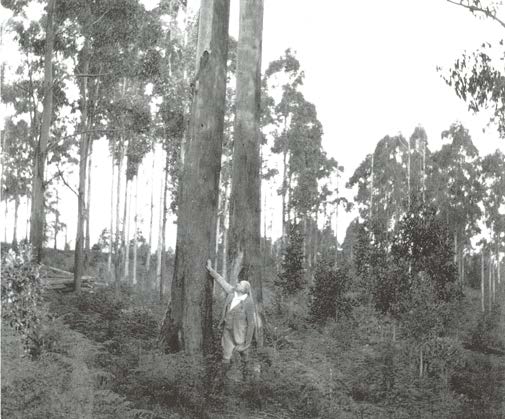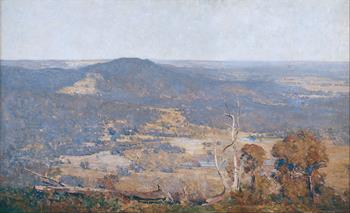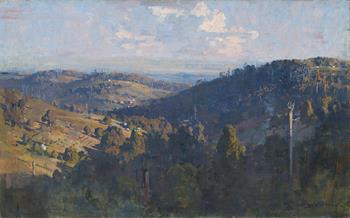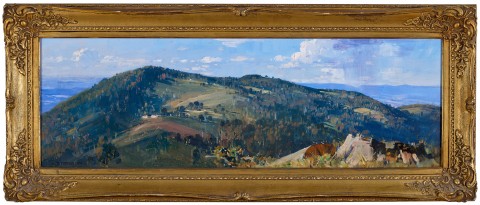NORTHERN VIEW, OLINDA, 1933
ARTHUR STREETON
oil on canvas
31.0 x 91.5 cm
signed lower left: A STREETON.
inscribed on frame verso: Streeton
framer's label attached verso: John Thallon, Melbourne
The Athenaeum Gallery, Melbourne
Mrs A. E. Ramsay, Victoria, acquired from the above in 1933
Thence by descent
Private collection, Victoria
A Retrospective Exhibition of Paintings by Arthur Streeton, The Athenaeum Gallery, Melbourne, 15 – 26 August 1933, cat. 40
Streeton, A., The Arthur Streeton Catalogue, Melbourne, 1935, cat. 1076
1 DH2022 ART Cat (May 2022) FA3.jpg

After living in London for more than a decade, Arthur Streeton returned to Australia with his wife and young son in 1920. The following year, he purchased five acres of land at Olinda in the Dandenong Ranges east of Melbourne, fulfilling a long-held ambition to establish what he once described as his own ‘pastoral treasury’. Following the sale of Golden Summer, Eaglemont, 1889 (National Gallery of Australia) for the extraordinary sum of 1000 guineas, he built a house there several years later and enthusiastically began to develop a garden against the backdrop of mature native blackwoods and gum trees. Writing to Tom Roberts in 1924, he enthused, ‘And the garden and the trees, what a delight it is. All through the winter I’ve put in my week-ends up there… working at the bramble and bracken… and planting no end of trees… blackwoods… Lambertiana Cypress… Acacia Elata’.1
Typically spending summers at Olinda, as well as making regular visits throughout the year, Streeton came to know the area well, and both his garden and the surrounding landscape feature in paintings produced during the 1920s and 30s. Continuing the practice established in his youth, of painting outdoors and working directly from the subject – as well as in the studio – Streeton captured the essence and the actuality of the landscape, skilfully combining fleeting atmospheric effects with recognisable geographical features. At the time, his paintings were recognised as symbols of Australian life and land, and today, Streeton is still widely acknowledged as the creator of quintessentially national images. Writing in 1931, Harold Herbert noted that, ‘His unfailing sureness is a source of wonder. His unerring vision and sense of colour and atmosphere in Australian landscape are unique. His work vibrates with realism’2. While many works of this time reflect Streeton’s familiarity with the region and his celebrated ability to capture the beauty of the landscape in paint, his strong belief in the importance of protecting the natural environment also emerged as a significant theme during these years, motivated in part by the transformation he witnessed as a result of active logging and clearing. Addressing the Forest League in 1925, he said, ‘It seems an amazing thing to me that a community which spends thousands of pounds on hospitals and homes… and which is progressive and businesslike in so many ways, should suffer hundreds and hundreds of acres of valuable timber to be destroyed to facilitate some work of the moment when so little is gained from it.’3
220462 Australia Felix 1.jpg

Presenting an expansive panoramic vista, Northern view, Olinda, 1933 looks from a high vantage point across to a nearby hill-top – densely treed, apart from a large central clearing – and the distant landscape beyond. Streeton places us in the landscape in this picture, and close to the sky, which is pale blue and scattered with clouds. Delicate vertical brushstrokes of purple on the right-hand side describe a rain shower in the distance, suggesting direct observation of the subject. The key to this image however, is the large felled tree in the right-hand corner. It is a subtle, yet powerful inclusion, the girth of the tree trunk signalling its age and symbolising the scale of the loss it represents. The strong environmental stance Streeton adopted in these works did not discourage serious collectors, indeed, it may well have encouraged buyers who both appreciated his artistic skill and shared his progressive opinions. The first owner of A mountain side, 1935 (Westpac Banking Corporation), for example, was Sir George Coles, founder of G. J. Coles & Co. retail stores. Similarly, Alfred Nicholas, who famously produced aspirin in Australia under the name Aspro, purchased The vanishing forest, 1934 (private collection) from its first exhibition. Northern view, Olinda was purchased from Streeton’s 1933 exhibition at the Athenaeum Gallery, Melbourne by Mrs Annie Ramsay (1871 -1953) and has remained in the family ever since. While her name is comparatively little known in the context of early twentieth century business figures, from 1923 – 33, she was the chairwoman of the Kiwi Polish Company, which had been founded by her husband, William (1868 – 1914). Indeed, it was her New Zealand heritage and nickname, ‘Kiwi Annie’, which inspired the name of this iconic Australian brand.4
220462 The Valley of Olinda.jpg

1. Streeton to Tom Roberts, 13 August 1924, quoted in Croll, R. H., Smike to Bulldog: Letters from Sir Arthur Streeton to Tom Roberts, Ure Smith Pty Ltd, Sydney, 1946, p. 119
2. Herbert, H., ‘Art of Arthur Streeton, Sunlit Landscapes, Beautiful Flower Pieces’, Argus, 17 March 1931, p. 8 quoted in Eagle, M., The Oil Paintings of Arthur Streeton in the National Gallery of Australia, National Gallery of Australia, Canberra, 1994, p. 154
3. Reported in the Argus, 27 November 1925, p. 23, quoted in Smith, G., Arthur Streeton 1867-1943, National Gallery of Victoria, Melbourne, 1995, p. 163
4. For more information about Annie Ramsay and the history of the Kiwi company, see Dunstan, K., Kiwi: the Australian Brand that Brought a Shine to the World, Allen and Unwin, Crows Nest, 2017. It is significant to note that the family was also directly associated with the art world through William’s brother, the distinguished painter, Hugh Ramsay (1877 – 1906).
KIRSTY GRANT

